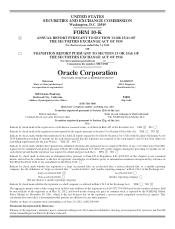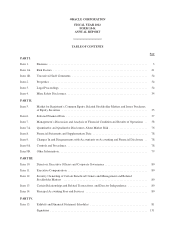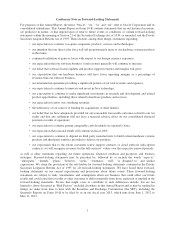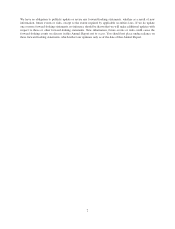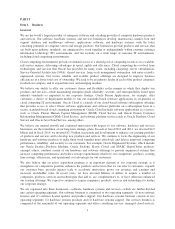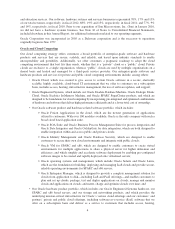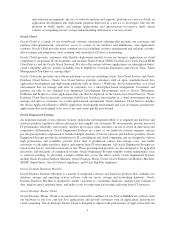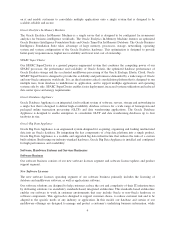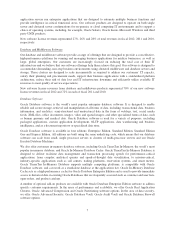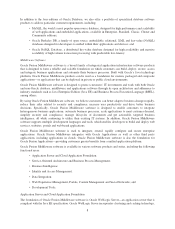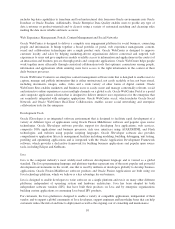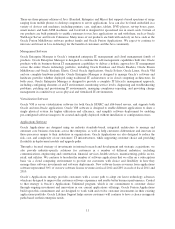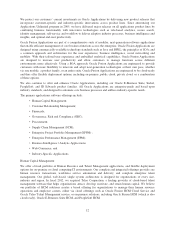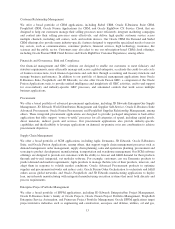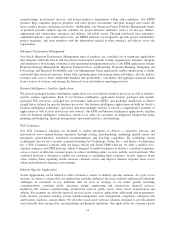Oracle 2012 Annual Report Download - page 8
Download and view the complete annual report
Please find page 8 of the 2012 Oracle annual report below. You can navigate through the pages in the report by either clicking on the pages listed below, or by using the keyword search tool below to find specific information within the annual report.
and education services. Our software, hardware systems and services businesses represented 70%, 17% and 13%
of our total revenues, respectively, in fiscal 2012; 68%, 19% and 13%, respectively, in fiscal 2011; and 77%, 9%
and 14%, respectively, in fiscal 2010. Prior to our acquisition of Sun Microsystems, Inc. (Sun) in January 2010,
we did not have a hardware systems business. See Note 16 of Notes to Consolidated Financial Statements,
included elsewhere in this Annual Report, for additional information related to our operating segments.
Oracle Corporation was incorporated in 2005 as a Delaware corporation and is the successor to operations
originally begun in June 1977.
Oracle and Cloud Computing
Our cloud computing strategy offers customers a broad portfolio of enterprise-grade software and hardware
products and services that are secure, scalable, and reliable, and based upon industry standards to enable
interoperability and portability. Additionally, we offer customers a pragmatic roadmap to adopt the cloud
computing environment that best fits their needs, whether that is a “private” cloud or a “public” cloud. Private
clouds are exclusive to a single organization, whereas “public” clouds are used by multiple organizations on a
shared basis and hosted and managed by a third-party service provider. Our enterprise-grade software and
hardware products and services for private and public cloud computing environments include, among others:
• Oracle Cloud, which was created to give access to certain Oracle software in a secure, elastically
scalable, highly available, cloud-based IT environment that we offer to customers on a subscription
basis, includes access, hosting, infrastructure management, the use of software updates, and support;
• Oracle Engineered Systems, which include our Oracle Exadata Database Machine, Oracle Exalogic Elastic
Cloud, Oracle Exalytics In-Memory Machine, and Oracle SPARC SuperCluster products, and which are
designed to be foundations for cloud computing by incorporating pre-integrated and optimized combinations
of hardware and software that deliver high performance efficiently and at a lower total cost of ownership;
• Our Oracle software product and hardware-related software portfolio, which includes:
O Oracle Fusion Applications in the cloud, which are the newest generation of applications
offered to customers. With over 100 modules available, Oracle is the only company with such a
broad cloud based application suite;
O Oracle SOA Suite and Oracle Business Process Management Suite for process integration and
Oracle Data Integrator and Oracle GoldenGate for data integration, which are both designed to
enable integration within and across public and private clouds;
O Oracle Identity Management and Oracle Database Security, which are designed to enable
customers to secure their own cloud environments and integrate with public clouds;
O Oracle VM for SPARC and x86, which are designed to enable customers to create virtual
environments for multiple applications to share a physical server for higher utilization and
efficiency; and which simplify and accelerate software deployment by enabling pre-configured
software images to be created and rapidly deployed onto virtualized servers;
O Oracle operating systems and management, which include Oracle Solaris and Oracle Linux,
which are the foundation for building, deploying and managing IaaS clouds and provide secure,
reliable operating environments for SPARC and x86 servers;
O Oracle Enterprise Manager, which is designed to provide a complete management solution for
clouds from application to disk—including IaaS and PaaS offerings—and enables customers to
plan and set up clouds; package, test and deploy applications on clouds; manage and monitor
clouds and applications on clouds; and meter, charge and optimize clouds over time; and
• Our Oracle hardware product portfolio, which includes our Oracle Engineered Systems hardware, our
SPARC and x86 based servers, and our storage and networking products, and which provides the
underlying mission-critical infrastructure for Oracle’s various cloud offerings and our customers’ and
partners’ private and public cloud offerings, including software-as-a-service (SaaS, software that we
offer on a subscription basis and deliver as a service to customers that includes access, hosting,
4

